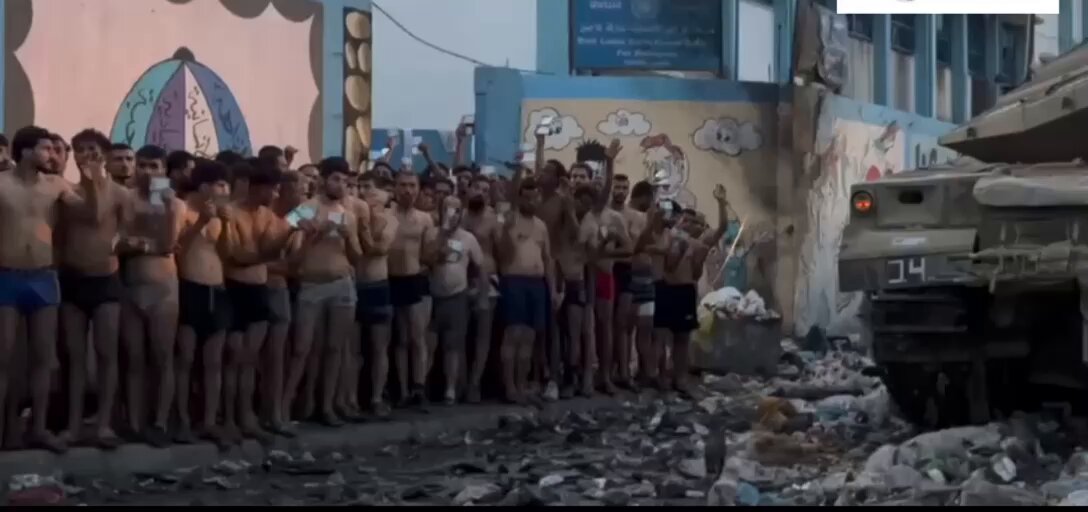IDF chief: Hamas rule in Gaza faltering; leaked video shows apparent gunmen surrender

Leaked footage from northern Gaza Strip shows an apparent Hamas member surrendering to Israeli troops along with dozens other Palestinians. IDF Chief Staff Lt. General Herzi Halevi stated that the military is beginning to witness the collapse of Hamas’ governing system.
The man is seen walking slowly past the tank, holding his gun and magazine above his head before he places them on the floor. Other Palestinians who are also wearing only underwear hold up their ID cards while standing across from the tank. A soldier is shouting orders in Arabic through a megaphone.
The soldier instructs the man holding the assault rifle to “Slowly” (slowly).
Social media had been flooded with images earlier this week of dozens men being held by Israel Defense Forces. Later, the army’s spokesperson said that it was questioning everyone who surrendered in the area after the fighting.
|
According to military officials, Hamas operatives are increasingly surrendering to IDF forces in other parts of Gaza as the fighting continues.
“I see the accomplishments every day.” “We are seeing more terrorists being killed and wounded every day. In recent days, we have seen terrorists surrendering – a sign of disintegration in the system and a sign we need to push even harder,” IDF chief of staff Lt.Gen. Herzi Halevi told Nahal Brigade troops at a Hanukkah Candle Lighting in the South.
Daniel Hagari, IDF spokesperson, confirmed that many Hamas members had surrendered to troops in Gaza on Saturday, revealing intelligence about the terror group’s operation during the ground offensive.
He confirmed that terrorists in Shejaiya & Jabaliya who had surrendered, handed over weapons & equipment.
Hagari stated that “from the interrogations with the terrorists who have surrendered the following intelligence emerged: the situation of Hamas operatives is difficult on the ground, and Hamas’ leadership, headed by [Yahya] sinwar, denies reality despite being updated on details,”
He added: “The Hamas leadership has no idea of the difficult situation that they face on the ground.”
Hagari stated that there is a “widespread belief that the Hamas underground leadership does not care for the people of Gaza aboveground,” adding that it also concerns Hamas operatives.
Hagari said that the intelligence gleaned from interrogations helped us to create more targets, and also aids in our operational activities.
The Kan public broadcaster also reported Saturday that Hamas leader Yahya sinwar fled the northern Gaza region at the start of the war, hiding in a convoy headed south.
The report cited an Israeli official who was familiar with the details. It said that Sinwar fled Gaza City in a vehicle which provided “humanitarian protection” and then headed to south Gaza’s Khan Younis. More details about the vehicle could not be published, according the broadcaster.
Israel said that it believed that Sinwar is still in Khan Younis or in one of its tunnels.
Members of the War Cabinet met Saturday night to discuss the ongoing fighting in Gaza and whether or not Palestinian workers should be allowed back into Israel following the Hamas led October 7 attack in which terrorists murdered around 1,200 people, including 240 hostages.
Itamar Gvir, the far-right Minister of National Security who met with the war cabinet on X, wrote: “Letting workers in the Palestinian Authority who have been soaked in incitement now into Israel is a continuation [of the failed] concept [that lead to October 7] as well as the understanding that we didn’t understand anything about October 7.
A senior Israeli official said to The Times of Israel that more than 200,000 Palestinians in the West Bank and Gaza Strip are entering their third month of not working in Israel. The IDF has imposed a partial blockade on the Gaza Strip and West Bank since the Hamas attacks.
Before the war, 150,000 Palestinians in the West Bank were allowed to work in Israel.
Estimates suggest that between 20,000 and 40,000 Palestinians are illegally entering the country to work in industries critical such as construction.
More than 17,000 Palestinians in Gaza had also been granted permits to legally work in Israel.
Israel, which has been claiming that it is essential to maintain security following the Hamas attack on October 7, has taken significant steps in restricting movement within the West Bank.
The Times of Israel reported that a second source with knowledge of the issue said Israel has allowed roughly 8,000 Palestinians in the West Bank to go back to work over the past few weeks.
Source: This minority works in industries that provide services essential to society, like sanitation, health care and hospitality.
Most of the 8,000 Palestinians who work inside Israel’s settlements on the West Bank are employed in these settlements.
The Green Line has largely been unable return.
Shlomo N’eeman, the head of the Yesha Council of Settler Mayors, wrote a letter this week to Benjamin Netanyahu urging him to not allow the Palestinian workers to return to the settlements. He referred to them as a threat to the residents.
The letter did not mention that almost 8,000 Palestinians are already back working in the settlements.
Netanyahu was asked to comment on the matter during a recent press conference. He said that the security establishment wants Israel to allow workers to return gradually, as mass unemployment could destabilize the West Bank.
He said that the issue would be discussed by the Security Cabinet before a decision is made.
The security cabinet met the next day but made no decision on the issue. Therefore, the Palestinian workers are expected to remain at home for a while.
The West Bank economy loses over $350 Million in revenue each month.
The PA is in a crisis due to not receiving the tax revenue it has been entitled to from Israel every month since the start of the war. Israel deducted $275 million dollars from Ramallah’s funds, causing the PA to refuse any of these revenues that make up more than 60% of their budget.
As a result, thousands of PA employees did not receive their salaries.









No Comments